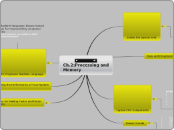Ch.2:Processing and Memory
1. The Motherboard ..memory
2. The CPU
3. Fans, Heat Sinks, and Other Cooling Components
4. Flash Memory
5. Registers
6. Random Access Memory (RAM
7. Processing Speed
8. Buses
undefined
Data and Program Representation
Digital Data Representation
• Bit: The smallest unit of data.
• Byte = 8 bits.
• Byte for the size of documents.
Prefixes for quantities of bytes: kilobyte (KB), megabyte (MB), gigabyte (GB), terabyte (TB)
Arithmetic/Logic Unit (ALU)
• Floating Point Unit (FPU):
• Control unit
• Prefetch unit
• Decode unit:
• Internal cache and registers
• Bus interface unit
• Nanotechnology
• Optical computer
• Silicon photonics
• Terascale computing
• 3D chips
• Machine language: Binary-based language for representing computer programs
• Most programs are written in other programming languages.
undefined
Improving the Performance of Your System Today
– Add more memory
– Perform system maintenance
– Buy a larger or second hard drive
– Upgrade your Internet connection
– Upgrade your video graphics card
1. Improved architecture
2. Improved materials
3. Pipelining
4. Multiprocessing and parallel processing
Ch3.Storage
Ch.1 :
Introduction to the World of Computers
Computers in Your Life
Pervasive computing
Basic computer literacy
Data vs. Information
Data
– Raw, unorganized facts
– Can be in the form of text, graphics, audio, or
video
Information
– Data that has been processed into a meaningful
form
Application software: Performs specific tasks or
applications
Programming Software
Software used as tools to build applications and other
software.
Computers and Society
Computer viruses and malware
– Identity theft and phishing
– Privacy issues
What Is a Computer
programmable, electronic device that
accepts data, performs operations
Basic operations
Input: Entering data into the computer
– Processing: Performing operations on the data
– Output: Presenting the results
– Storage: Saving data, programs, or output for future
use
– Communications: Sending or receiving data
Hardware
Internal hardware
External hardware
Computers to Fit Every Need
Six basic categories of computers:
– Embedded computers
– Mobile devices
– Personal computers
– Midrange servers
– Mainframe computers
– Supercomputers
What Are the Internet and the
World Wide Web?
Accessing a Network or the Internet
IP Addresses and Domain Names
Uniform Resource Locators (URLs)
